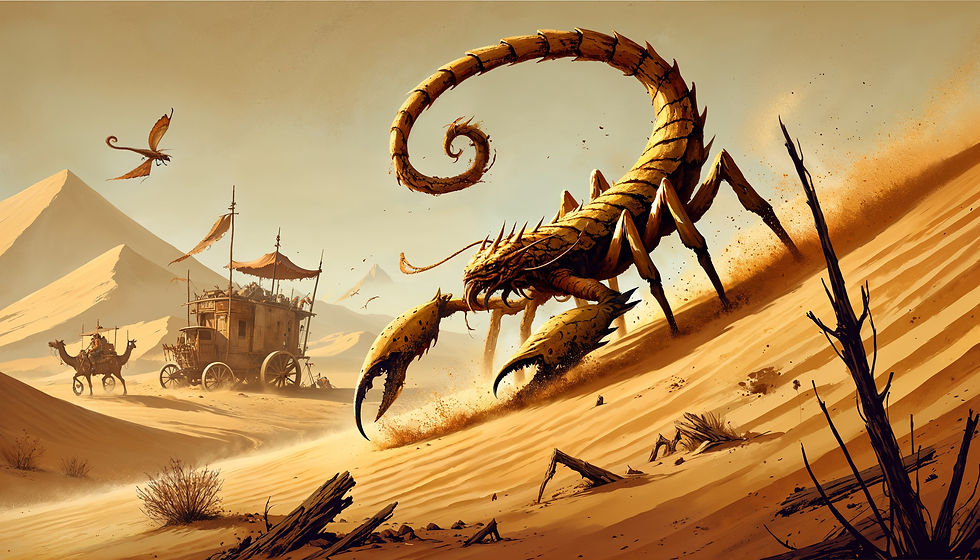How to Build a Memorable Campaign Setting from Scratch
- Laurie

- Dec 16, 2024
- 4 min read
Updated: Jan 21
So, you want to create a campaign setting that your players will talk about for years? One that’s packed with unforgettable moments, epic locations, and just the right amount of chaos to keep everyone on their toes? One where they’ll remember every tavern, every shady NPC, and every trap-filled ruin with a mix of nostalgia and PTSD? Good news: you’re in the right place. Let’s build a world so immersive your players will start asking if they can vacation there IRL (minus the gelatinous cubes).

Step 1: Start with the Big Picture
Before you dive into sketching out individual villages or deciding how many types of bread your fantasy bakers sell, zoom out. Ask yourself some big questions:
What’s the vibe? High fantasy with gleaming knights and dragons, or gritty post-apocalyptic wasteland where water is currency? (Note: Nobody likes water taxes in real life. Don’t let that stop you in fantasy.)
What’s the major conflict? Is there a war brewing, a dark god waking, or just a shortage of good coffee?
Who are the power players? Think kingdoms, guilds, religious orders, criminal syndicates, or even sentient squirrels—whatever fits your vibe.
Once you’ve answered these, jot down a paragraph or two that sums up the essence of your world. This will be your North Star when things get messy later.
Step 2: Draw a Map (Or Pretend You Did)
Maps are like cheat sheets for your imagination. They help keep your world consistent during gameplay by giving you a visual reference for distances, locations, and terrain, ensuring that your players don’t mysteriously walk from a desert to a tundra in a single day. Even if you’re no cartographer, a rough sketch of the world can help keep things organized. Grab some paper (or a napkin—I’ve been there), and start drawing:
Landmarks: Mountains, forests, rivers, and deserts make great natural barriers for storylines and travel excuses. “Sorry, you can’t get to the wizard’s tower because of the Lava Chasm of Certain Death.”
Regions: Divide the world into regions or kingdoms, each with distinct characteristics. Maybe the northern lands are icy and ruled by a stoic queen, while the southern isles are a paradise of pirates and rum.
Major Locations: Plop down a few key cities, ruins, and mysterious “Here Be Dragons” zones. Bonus points if you give the cities fun names like Coppercliff, Verdant Hollow, or My-Fantasy-Name-Generator-Is-Broken.
If you’re feeling fancy, there are free online tools like Inkarnate and Wonderdraft that can make your map look professional enough to frame.
Step 3: Sprinkle in Some Lore
Your players don’t need a history book, but they do need context. Start small. Pick a handful of interesting tidbits to weave into your world:
Mythology: Create a couple of gods, legends, or ancient events. (Pro tip: “Everything was fine until [insert disaster]” works great.)
Politics: Who’s in charge, and who’s scheming to take over? Political intrigue can add depth to even the simplest quest.
Weird Stuff: Every great world has something that makes players go, “Wait, WHAT?” Maybe it’s a wandering island that appears every full moon or a desert ruled by a talking coyote.
Keep it loose. You’ll flesh this out more as the story progresses. For instance, a vague idea like “this forest has a mysterious aura” might evolve into a major plot arc involving an ancient druidic curse or a hidden portal to another plane. For now, focus on flavor—not homework.
Step 4: Build Interesting Factions
Nothing says “engaging world” like a good ol’ fashioned faction feud. Think about the groups shaping your world’s destiny:
Political Powers: Kingdoms, empires, city-states, or republics. Are they allies or rivals? Peaceful or always on the verge of war?
Religious Orders: Are there competing faiths? Secret cults? A group of druids who believe the trees should vote?
Underground Networks: Thieves’ guilds, smugglers, or freedom fighters. Everyone loves a shady character with a heart of gold (or at least bronze).
Factions add layers to your story and give players plenty of ways to make friends (or enemies).
Step 5: Tie in Your Players’ Backstories
This is the secret sauce. A world isn’t truly memorable unless the characters feel like they belong in it. Work with your players to tie their backstories into the world’s lore:
Is one player a knight? Maybe their family swore fealty to the northern queen.
Is another player a rogue? Perhaps they’ve stolen from the local thieves’ guild and are now on the run.
Does someone want to play a warlock? Oh, perfect. That dark god waking up? It’s their patron. And who knows, maybe their awakening sets off a chain of events that disrupts the entire political landscape or turns an ally into a secret foe. The possibilities are endless when backstories weave into the larger plot.
Collaborating with your players makes the world feel alive and personal. Plus, it takes some of the workload off you—win-win!
Step 6: Add Details as You Go
Here’s a hot take: You don’t have to know everything about your world before Session 1. In fact, this can be your biggest strength as a new DM—leaving room for creativity and player-driven ideas to shape the narrative as it unfolds. Start with the basics and let the rest unfold naturally. Your players will ask questions you didn’t anticipate (“What’s the regional cheese specialty?”), and you can make up answers on the spot. It’s called creativity… or bluffing. Either way, you’re golden.
The Takeaway
Building a campaign setting is a mix of planning, improvisation, and a dash of chaos. Start broad, dive into the fun details, and let your players shape the world alongside you. Remember: It doesn’t have to be perfect—it just has to feel real enough for your party to fall in love with it.
Now go forth, map in one hand and dice in the other. Your epic world awaits!



Comments